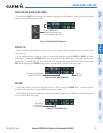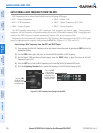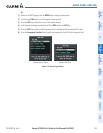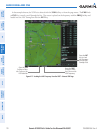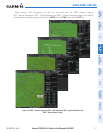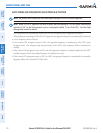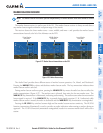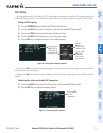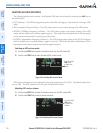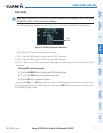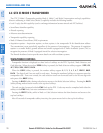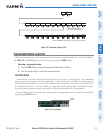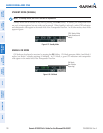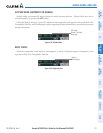
190-00592-06 Rev. A
Garmin G1000 Pilot’s Guide for the Diamond DA40/40F
114
AUDIO PANEL AND CNS
SYSTEM
OVERVIEW
FLIGHT
INSTRUMENTS
EIS
AUDIO PANEL
& CNS
FLIGHT
MANAGEMENT
HAZARD
AVOIDANCE
AFCS
ADDITIONAL
FEATURES
APPENDICESINDEX
ADF/DME TUNING
NOTE: When another auxiliary window is turned on, the ADF/DME Tuning Window is replaced on the PFD.
See the Flight Instruments Section for displaying the DME and bearing information windows (ADF) and
using the ADF as the source for the bearing pointer.
The G1000 system tunes the ADF receiver (optional) and DME transceiver (optional). The ADF is tuned by
entering the frequency in the ADF standby frequency field of the ADF/DME Tuning Window. (The softkey may
be labeled ADF/DME, ADF, or DME, depending on installed equipment.)
The UHF DME frequency is tuned by pairing with a VHF NAV frequency. DME frequency pairing is automatic
and only the VHF NAV frequency is shown.
The following ADF/DME information is displayed in the ADF/DME Tuning Window:
•Active and standby ADF frequencies
•ADF receiver mode
•ADF receiver volume
•DME tuning mode (DME transceiver pairing)
When the ADF/DME Tuning Window is displayed, the selection cursor is placed over the standby ADF
frequency field.
Turning the large
FMS
Knob moves the selection cursor through the various fields (standby ADF frequency,
ADF receiver mode, ADF radio volume, and DME tuning mode). Pressing the
FMS
Knob activates/deactivates
the selection cursor in the ADF/DME Tuning Window. The ADF frequency is entered using the FMS Knob and
the ENT Key.
Figure 4-29 ADF/DME Tuning Window
Active ADF Frequency Standby ADF Frequency
ADF
Mode
DME
Tuning
Mode
ADF
Volume




